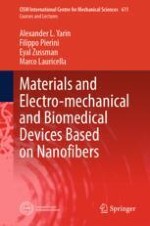2024 | OriginalPaper | Buchkapitel
3. Polyelectrolyte Nanofibers
verfasst von : Alexander L. Yarin, Filippo Pierini, Eyal Zussman, Marco Lauricella
Erschienen in: Materials and Electro-mechanical and Biomedical Devices Based on Nanofibers
Verlag: Springer Nature Switzerland
Aktivieren Sie unsere intelligente Suche, um passende Fachinhalte oder Patente zu finden.
Wählen Sie Textabschnitte aus um mit Künstlicher Intelligenz passenden Patente zu finden. powered by
Markieren Sie Textabschnitte, um KI-gestützt weitere passende Inhalte zu finden. powered by
